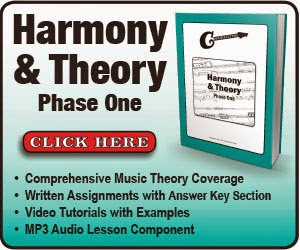BADASS GUITAR DRILL: Scales, Arpeggios, Chords
How are you practicing guitar scales? Do you include the chord associated to the scale? Are you taking the time to include practice on the arpeggio that relates to the scale and chord? If not, you're really missing out on a fantastic study drill that will push your playing up into seriously "Badass" guitar player territory...
In this lesson – I discuss one of the most important concepts covered in every professional guitar course taught by all of the major institutes. It has to do with the way a guitarist would be studying the development of their scales, arpeggios and chords in relation to both performing them and the lengthy study involved with their general training.
WATCH THE VIDEO:
TYPICAL LEARNING - NOT VERY BAD-ASS!
The way that a guitarist will typically learn on their own is quite different to how a player would be studying material if they were involved in a guitar course. When students study on their own they tend to focus on the scales the most, with the chords generally coming in second and the arpeggios a distant 3rd.
This isn’t the best way to go about it, so in this lesson, I’m going to teach you a Badass Guitar Drill "practice approach" that involves hitting all three at once!
STEP 1 - SCALE:
The first thing I want to do is have a run through a typical scale shape on the guitar. For our example, I’ll be using the “Pattern #1” Major Scale shape (taken from the curriculum in my advanced guitar program). Here’s how that scale looks played off of a Tonic note of “F”
STEP 2 - ARPEGGIO:
The next shape that we’ll be going over will be the arpeggio that is directly associated to the scale shape we just covered. In my curriculum the scales and arpeggios actually directly link to one another. So, in this case we’ll learn the “Pattern #1” arpeggio from the major scale. And, since in this system, each pattern will be established off of the same tonal name, this ends up giving us the, “F Major 7th,” arpeggio…
STEP 3 - CHORD:
The final idea to link everything together and complete all three elements of our study (that works to cover one fingerboard positions scale, arpeggio and chord), is going to be organizing the chord (that also directly associates to the scale, and to the arpeggio which was just completed in the previous studies).
In my curriculum, (Advanced Guitar Program), everything is associated. So, the chord pattern that we’ll be using will have the same pattern name, it will be titled as a, “Pattern #1,” “F Major 7th,” chord…
Here’s what that chord looks like on the guitar fingerboard…
WHY DO THIS?
This style of exercise (with chords, scales and arpeggios all studied as one collective process) is extremely important, because it takes these three primary areas of a guitarist’s work and directs the whole process at a single “fingerboard study” of material where everything is related.
This process combines them so that the player begins comprehending these ideas as a singular principle on the guitar neck. Plus, it also helps the guitarist realize what they can combine during the performance of a piece of music.
It’s not at all uncommon, for a rhythm guitar player to decide to add in a few tasty licks or melody lines around a rhythm part that they’re performing in a song. In fact it happens quite often. And, learning a system like this can be extremely beneficial when it comes to the application of scales, arpeggios and chords.
CONCLUSION:
Now that you understand the basic principles of this practice system, take it upon yourself to apply the process to every scale you know. For example, if you were studying a mode like “Dorian,” this scale would lead you to an associated arpeggio of “Minor 7th.” And, the associated chord would also be Minor 7th.
If you wanted to, you could study the triads instead of the seventh quality arpeggios and chords. Or, you could add the triads, (i.e., Scale, Triad Arpeggio, Seventh Arpeggio, Chord). It’s totally up to you.
The take-away on all this is, once you learn the process in one region of the neck, you can take it all across the fingerboard. It can be done with any scale type and it can be done in every musical key.
Just imagine the working knowledge you’d have over your guitar neck if you spent a number of weeks applying this principle to all of the scales that you know right now. Your recognition of how all of these important guitar theory elements both combine and associate to the fret-board, would be absolutely badass.
VISIT THE WEB-SITE:
Well, hey, thanks for joining me, If you'd like to Find Out What You Should Learn Next on Guitar - take a look at the courses over on my website at CreativeGuitarStudio.com.
My step-by-step; Beginner, Intermediate and Advanced courses will cover what you need to know, along with how to be able to move forward and become the best player that you can be.
I've worked on these courses since 1992 and I feel that all together they're the best guitar program you'll ever find. The courses will help you learn to identify what's required to get you up to the next level of guitar playing, in a very organized way, that makes sense.
So, I look forward to helping you further at CreativeGuitarStudio.com ...Until next time - take care and we'll catch up again on the next lesson. Bye for now!
In this lesson – I discuss one of the most important concepts covered in every professional guitar course taught by all of the major institutes. It has to do with the way a guitarist would be studying the development of their scales, arpeggios and chords in relation to both performing them and the lengthy study involved with their general training.
WATCH THE VIDEO:
TYPICAL LEARNING - NOT VERY BAD-ASS!
The way that a guitarist will typically learn on their own is quite different to how a player would be studying material if they were involved in a guitar course. When students study on their own they tend to focus on the scales the most, with the chords generally coming in second and the arpeggios a distant 3rd.
This isn’t the best way to go about it, so in this lesson, I’m going to teach you a Badass Guitar Drill "practice approach" that involves hitting all three at once!
STEP 1 - SCALE:
The first thing I want to do is have a run through a typical scale shape on the guitar. For our example, I’ll be using the “Pattern #1” Major Scale shape (taken from the curriculum in my advanced guitar program). Here’s how that scale looks played off of a Tonic note of “F”
STEP 2 - ARPEGGIO:
The next shape that we’ll be going over will be the arpeggio that is directly associated to the scale shape we just covered. In my curriculum the scales and arpeggios actually directly link to one another. So, in this case we’ll learn the “Pattern #1” arpeggio from the major scale. And, since in this system, each pattern will be established off of the same tonal name, this ends up giving us the, “F Major 7th,” arpeggio…
STEP 3 - CHORD:
The final idea to link everything together and complete all three elements of our study (that works to cover one fingerboard positions scale, arpeggio and chord), is going to be organizing the chord (that also directly associates to the scale, and to the arpeggio which was just completed in the previous studies).
In my curriculum, (Advanced Guitar Program), everything is associated. So, the chord pattern that we’ll be using will have the same pattern name, it will be titled as a, “Pattern #1,” “F Major 7th,” chord…
Here’s what that chord looks like on the guitar fingerboard…
WHY DO THIS?
This style of exercise (with chords, scales and arpeggios all studied as one collective process) is extremely important, because it takes these three primary areas of a guitarist’s work and directs the whole process at a single “fingerboard study” of material where everything is related.
This process combines them so that the player begins comprehending these ideas as a singular principle on the guitar neck. Plus, it also helps the guitarist realize what they can combine during the performance of a piece of music.
It’s not at all uncommon, for a rhythm guitar player to decide to add in a few tasty licks or melody lines around a rhythm part that they’re performing in a song. In fact it happens quite often. And, learning a system like this can be extremely beneficial when it comes to the application of scales, arpeggios and chords.
CONCLUSION:
Now that you understand the basic principles of this practice system, take it upon yourself to apply the process to every scale you know. For example, if you were studying a mode like “Dorian,” this scale would lead you to an associated arpeggio of “Minor 7th.” And, the associated chord would also be Minor 7th.
If you wanted to, you could study the triads instead of the seventh quality arpeggios and chords. Or, you could add the triads, (i.e., Scale, Triad Arpeggio, Seventh Arpeggio, Chord). It’s totally up to you.
The take-away on all this is, once you learn the process in one region of the neck, you can take it all across the fingerboard. It can be done with any scale type and it can be done in every musical key.
Just imagine the working knowledge you’d have over your guitar neck if you spent a number of weeks applying this principle to all of the scales that you know right now. Your recognition of how all of these important guitar theory elements both combine and associate to the fret-board, would be absolutely badass.
VISIT THE WEB-SITE:
Well, hey, thanks for joining me, If you'd like to Find Out What You Should Learn Next on Guitar - take a look at the courses over on my website at CreativeGuitarStudio.com.
My step-by-step; Beginner, Intermediate and Advanced courses will cover what you need to know, along with how to be able to move forward and become the best player that you can be.
I've worked on these courses since 1992 and I feel that all together they're the best guitar program you'll ever find. The courses will help you learn to identify what's required to get you up to the next level of guitar playing, in a very organized way, that makes sense.
So, I look forward to helping you further at CreativeGuitarStudio.com ...Until next time - take care and we'll catch up again on the next lesson. Bye for now!
___________________________________________________
GET GOOD NOW - JOIN THE MEMBERS AREA
Guitar Chords | F Chord | Guitar Notes | G Chord | C Chord | D Chord | Guitar String Notes














